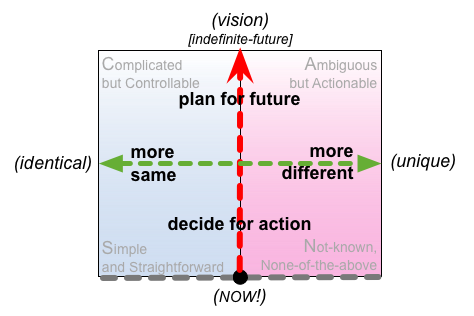Dotting the joins
Have we gone dotty? – all the way out to the level of the entire economy? And if we have, what can we usefully do about it?
It’s a metaphorical question, of course – but perhaps not quite in the usual sense…
Let’s go back to the beginning here. There I am, sitting in the aptly-named waiting-room at my local walk-in clinic, waiting to be called in for the routine blood-test that’s yet another disjointed part of my annual health-checkup. I’m thinking idly about how the term ‘patient’ has become more adjective than noun, and wondering why the National Health Service has pretty much lost track of the meaning of each of those three words. And I’m pondering on an item that drifted by on the Twitterstream just before I set out to go here:
RT @tonyamckinney: 200, 19, 1.5…the average medical record is 200 pages in 19 locations, weighing 1.5 lbs. My sympathy grows for healthcare CIOs
Yeah, that’d be about right in my case, too, given my all-too-literal career around the globe over the past too many decades. It’s a heck of a problem for anyone who’s trying to join up the dots in anyone’s health-care.
Join up the dots… My eye falls on an abandoned magazine a couple of seats away. It’s open at the ‘children’s puzzles’ page, and some child has been at it, all right: a random scrawl of coloured pens across the ‘colouring-in’ picture, and wobbly lines connecting between the dots in the join-the-dots puzzle. From the pre-printed pattern, the picture looks like it’s supposed to be a doctor, but with half of those wavy lines failing to join up with their dots it’s kinda difficult to tell. A bit like the health-service itself these days, in fact. Hmm…
Wait a minute, though – haven’t we got this back to front? Trying to join up the dots, when the real problem is that we keep dotting the joins? – breaking things up into small and smaller and ever-smaller supposedly-‘controllable’ chunks, and then losing track of any sense of the whole-as-whole?
Because in reality, that’s what specialisation does: it clusters all of its attention in one small area, and all but ignores the rest as Somebody Else’s Problem. It makes a dot, somewhere in the whole. And then someone else makes their own dot, and someone else carves out a space to claim to make their dot. And then we get hyperspecialisation – dots within dots, and then dots within dots within dots, onward seemingly to infinity. But there’s nothing to link those dots together, to link between the dots – that’s the problem here.
Just to make things worse, this dotty game of specialisation pulls all of the attention towards the samenesses of the world – and hence drawing attention away from the equally-real differences.
Which is why we end up with the common delusion that most of the world consists of samenesses, or that it ‘should’ consist of nice, safe, sensible, predictable samenesses – when in reality it mostly doesn’t.
Oops…
The real world is a continuum of same and different, intent and action. To make sense within that world, decide within that world, and act within that world, we first need to acknowledge that it is a continuum – a dynamic continuum – and be aware at each moment where we are and where we’re moving towards within that overall context-space:
Yet that continuum is broken the moment someone places an arbitrary dot in that context-space, and says “This is mine! This is the truth!” Any form of specialism – and especially specialism without a solid generalism to link it always with everything else – places at risk the analogue continuity of the real world, breaking it up into digital fragments with no inherent continuity at all. Overly-simplified digital dots, needing to fake up an illusion of continuity between them that isn’t actually there.
From an enterprise-architecture perspective, just about every organisation and context is fragmented, shattered, into arbitrary silos, arbitrary fiefdoms, arbitrary dots. An incomplete, uneven splatter of dots, like a child’s spray-painting on the school-room wall. Often there are great gaps in the picture, great glaring gaps of Somebody Else’s Problem that end up being No-One’s Responsibility – or, more accurately, Responsibility That Everyone’s Evading. Oops…
Which is why a typical customer-journey that tackles any real-world need – a simple health-check, for example – can easily become a tortuous traverse across a tangled confusion of misconnected, disconnected, disjointed non-‘services’, creating frustration, waste and worse for everyone at every step. Not a good idea…
And the whole mess happens because our dysfunctional cultures so much urge people to go dotty. The urgent need to join the dots arises only because of that relentless tendency towards dotting the joins.
Not helpful. Not helpful for anyone, or anything.
Surely we can do better than this?

Leave a Reply